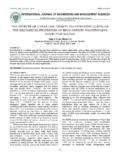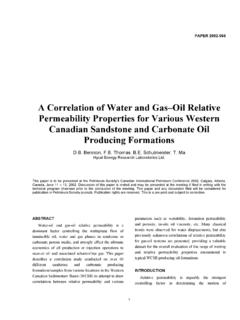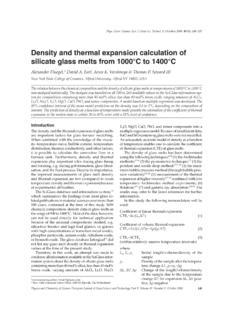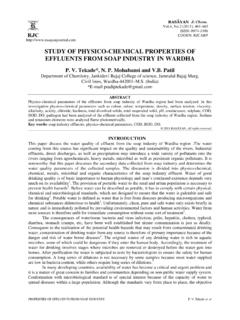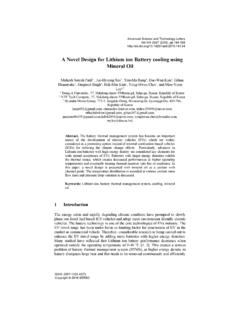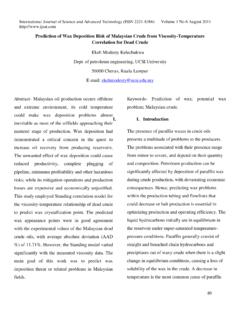Transcription of EFFECTS OF TEMPERATURE-DEPENDENT VISCOSITY …
1 Brazilian Journal of Chemical ISSN 0104-6632. Printed in Brazil Engineering Vol. 31, No. 03, pp. 787 - 797, July - September, 2014. EFFECTS OF TEMPERATURE-DEPENDENT . VISCOSITY ON FLUID FLOW AND HEAT. TRANSFER IN A HELICAL RECTANGULAR. DUCT WITH A FINITE PITCH. Cuihua Wang1,2, Shengju Liu1, Jianhua Wu1,2* and Zhang Li3. 1. School of Energy and Power Engineering, Shenyang University of Chemical Technology, Shenyang, Liaoning 110142, China. E-mail: 2. School of Chemical Engineering and Technology, Tianjin University, Tianjin 300072, China. 3. School of Chemical Engineering, Shenyang University of Chemical Technology, Shenyang, Liaoning 110142, China. (Submitted: April 27, 2013 ; Accepted: October 13, 2013). Abstract - An incompressible fully developed laminar flow in a helical rectangular duct having finite pitch and curvature with TEMPERATURE-DEPENDENT VISCOSITY under heating condition is studied in this work. Both the cases of one wall heated and four walls heated are studied.
2 The cross-sectional dimensions of the rectangular duct are 2a and 2b. The aspect ratio = 2b 2a is Water is used as the fluid and Reynolds number (Re) is varied in the range of 100 to 400. The secondary flow with TEMPERATURE-DEPENDENT VISCOSITY is enhanced markedly as compared to constant VISCOSITY . An additional pair of vortices is obtained near the center of the outer wall at Re=400 for the model of four walls heated with TEMPERATURE-DEPENDENT VISCOSITY , y, while for constant VISCOSITY , the appearance of two additional vortices near the outer wall cannot be found. Besides, the axial velocity decreases and the temperature increases at the central region of the rectangular duct when the TEMPERATURE-DEPENDENT VISCOSITY is considered. Due to the decrease of the VISCOSITY near the walls, the friction factor obtained with TEMPERATURE-DEPENDENT VISCOSITY is lower than that of constant VISCOSITY , while the convective heat transfer for TEMPERATURE-DEPENDENT VISCOSITY is significantly enhanced owing to the strengthened secondary flow.
3 Especially for four heated walls, the EFFECTS of VISCOSITY variation on the flow resistance and heat transfer are more significant. Keywords: TEMPERATURE-DEPENDENT ; Helical Rectangular Duct; Flow resistance; Heat transfer. INTRODUCTION The VISCOSITY varies more markedly than the other thermo-physical properties for most liquids, so The problem of temperature-varying properties plenty of researcher on the variation of VISCOSITY has of the fluid is more complex than that of constant been performed in the literature. A few studies on properties. The different property ratio correlations fluid flow and heat transfer for temperature-depend- of different fluids increase the complexity of the ent thermo-physical properties in straight tubes with variable-temperature properties problem. It is also circular cross section have been carried out, , by difficult to give a correction for the temperature- Shah and London (1978), Harms et al. (1998) and dependent behavior of all viscous liquids in all tubes.
4 Kakac (1987). Shah and London reported the laminar *To whom correspondence should be addressed 788 Cuihua Wang, Shengju Liu, Jianhua Wu and Zhang Li flow and heat transfer of gases and liquids and and none considered helical rectangular ducts. The Harms et al. gave reasonable predictions for many purpose of this paper is therefore to investigate the fluids with corrections based on different models for effect of TEMPERATURE-DEPENDENT VISCOSITY on the TEMPERATURE-DEPENDENT behavior. However, both the laminar flow and heat transfer in helical rectangular range of temperature and the forms of geometries ducts having finite curvature and pitch. The flow is considered were limited. Kakac developed a correc- considered to be steady, and hydrodynamically and tion for the TEMPERATURE-DEPENDENT VISCOSITY effect thermally fully developed. Both the cases of constant on Nusselt number and the friction factor of laminar temperature at one heated wall and four heated walls flow.
5 Are simulated. The hydrodynamics and thermal pro- There are also many studies of fluid flow and heat files for varied VISCOSITY flow are presented and com- transfer in straight rectangular ducts, but only several pared with those for constant VISCOSITY flow. The fric- of them considered the variation of the fluid proper- tion factor and Nusselt number results are predicted ties dependent on temperature. Sehyun Shin (1993, considering the TEMPERATURE-DEPENDENT VISCOSITY . 1994) and Chang-Hyun Sohn (2006) investigated the influence of variable VISCOSITY of temperature-de- pendent fluids on the laminar heat transfer and fric- GOVERNING EQUATIONS. tion factor in straight rectangular ducts. They re- ported that the effect of TEMPERATURE-DEPENDENT vis- Figure 1 illustrates the geometry and systems of cosity on the laminar heat transfer is more significant coordinates for the helical rectangular duct, where, in a non-circular duct than in a circular duct because, Rc is the curvature radius of the helical duct; H is the in the latter, a symmetric thermal boundary condition so-called pitch; 2a and 2b are the width and height of must be used and the effect of variable VISCOSITY on the cross section, respectively.
6 (r, , z) are the cylin- heat transfer cannot be capitalized. Mohamed Eissa drical coordinate system and vr, v , vz are the corre- (2000) studied the fully developed MHD laminar sponding velocity components. Neglecting viscous flow and heat transfer through a rectangular duct of a dissipation and axial conduction, the governing viscous incompressible electrically-conducting fluid. equations for a steady, incompressible, fully devel- Since enhanced heat transfer in curved tubes due oped laminar flow can be written in the cylindrical to the secondary flow was first reported by Dean coordinate system as (Rennie and Raghavan, 2006). (1927), more and more TEMPERATURE-DEPENDENT prop- erties problems in curved tubes have been studied. Bergles et al. (1983) investigated a curved circular r, vr s, w y, v tube neglecting the curvature EFFECTS . Kumar et al.(2007) and Andrade and Zaparoli (2001) reported o x, u the flow and heat transfer for both heating and cool- Rc ing conditions in a curved circular tube with tem- perature -dependent properties.
7 The former took into account four thermo-physical properties variations of water with increasing temperature and their results showed that the specific heat and thermal conductiv- ity have negligible EFFECTS on the velocity and ther- H. mal profiles and density has a small effect, while VISCOSITY plays the dominant role. The latter study focused on the EFFECTS of varying VISCOSITY on the 2b fully developed laminar flow and heat transfer for 2a the case of water, and indicated that the frictional factor and the Nusselt number for water are mark- Figure 1: Schematic geometry and coordinates of edly dependent on the VISCOSITY . the helical rectangular duct model. Helical rectangular ducts have an extensive appli- cation in industrial processes, such as in heat ex- The continuity equation is: changers, ventilators, gas turbines, aircraft intakes and centrifugal pumps (2005). It is clear that all the v r 1 v v z v r + + =0 (1). literature mentioned above considered the variation r r z r of the fluid properties dependent on the temperature in straight rectangular ducts or circular curved ducts The momentum equations are: Brazilian Journal of Chemical Engineering EFFECTS of TEMPERATURE-DEPENDENT VISCOSITY on Fluid Flow and Heat Transfer in a Helical Rectangular Duct with a Finite Pitch 789.
8 V r v v r v v 2 The no-slip boundary condition at the walls of the vr + + vz r . r r r r duct gives vr= v = vz=0, and constant temperature (Tw) is imposed on the heated wall. For the model of 1 p 1 v r 1 2v r (2) one heated wall, the inner wall is the heated wall and = + ( (r )+ 2. r r r r r 2 the others are adiabatic walls. 2 v r v r 2 v . + ). z 2 r 2 r 2 VELOCITY TRANSFORMATION AND. ANALYSES. v v v v vv vr + + vz r . r r r r In Figure 1, (x, y, s) is an orthogonal helical coor- dinate system and u, v, w are the velocity compo- 1 p 1 v 1 2v (3). = + ( (r )+ 2 nents in the x, y, s directions; w is the axial velocity r r r r 2 of the spiral orthogonal coordinate system and u, v constitute the secondary flow. According to Germano 2 v v 2 v r + + ) (1989), u, v, w can be derived from vr, v , vz as: z 2 r 2 r 2 . w = sin cos vr + cos cos v +sin vz (7). v z v v z v vr + + vz z r r r (4) u = cos v r sin v (8). 1 p 1 v z 1 vz vz 2 2.
9 = + ( (r )+ 2 + 2 ). r r r r 2 z v = sin sin v r cos sin v + cos v z (9). The energy equation is: K(z-z o ). sin = , sin = K R c2 +K 2 , K 2 +R c r T v T T (10). vr + + vz r r z (5) cos = R c 2. R +K 2. c 2T 1 T 1 2T 2T. = ( + + + ). c p r 2 r r r 2 2 z 2 where K=H/2 ; is the slope of the centerline rela- tive to the plane z =constant; is the angle along the where is the density; p is the pressure; T is the centerline; zo is the ordinate value of the midpoint in the cross section. temperature; is the thermal conductivity; cp is the Dimensionless parameters are defined as follows: specific heat at constant pressure; is the VISCOSITY and is dependent on the temperature of the flow. For water, the TEMPERATURE-DEPENDENT VISCOSITY can be x ' = x/ d h , y ' = y/ d h , w ' = w/ w m , (11). calculated using a polynomial function of the form: (u',v')= (u,v)d h / . =A 0 +A1T+A 2 T 2 +A 3T 3 +A 4 T 4 +A 5T 5 (6). =R c d h /(R c2 +K 2 ) , =Kd h /(R c2 +K 2 ) (12).
10 Where Ai (i=1, 2, 3, 4, and 5) are coefficients deter- mined by a polynomial fitting of the VISCOSITY data of Here dh= 4ab (a + b) is the hydraulic diameter for a water with MATLAB. The maximum deviation of rectangular cross-section, wm is the mean value of Eq. (6) from the VISCOSITY data is less than and the axial velocity, and and are the dimensionless the fitting values of Ai are shown in Table 1. curvature and torsion ratio, respectively. The vorticity is defined as: Table 1: Coefficients of TEMPERATURE-DEPENDENT VISCOSITY for Water. = v' x' u' y' (13). Coefficient A0 A1 A2 A3 A4 A5. Here Re=d h w m / . Value E10-02 E10-04 E10-07 4E10-10 E10-13. The Nusselt numbers are obtained as: Brazilian Journal of Chemical Engineering Vol. 31, No. 03, pp. 787 - 797, July - September, 2014. 790 Cuihua Wang, Shengju Liu, Jianhua Wu and Zhang Li A. comparative results indicate that this simulation Nu l = l H , Nu m = 0. hd Nu l dA w (14) method is accurate.










